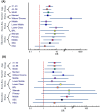Prevalence of psychiatric disorders among the adult population in a rural community of Jammu, India: a cross-sectional study
- PMID: 39524129
- PMCID: PMC11543848
- DOI: 10.3389/fpsyt.2024.1433948
Prevalence of psychiatric disorders among the adult population in a rural community of Jammu, India: a cross-sectional study
Abstract
Background: Mental health is crucial for overall well-being, but rural areas often face difficulties in accessing mental health services and understanding psychiatric disorders.
Aim: This study aimed to address these issues by assessing the prevalence of psychiatric disorders among adults in rural Jammu and examining how socio-cultural and demographic factors are related to these disorders.
Methods: A sample of 1,016 adults from rural Jammu was surveyed using the Mini International Neuropsychiatric Interview (MINI). Data were collected through house-to-house visits conducted by trained investigators. Descriptive and inferential statistics, including frequency distribution and odds ratio, were employed to analyze the data respectively.
Results: Overall, 20.67% of the participants had a psychiatric disorder. Alcohol dependence was the most common condition, affecting 12.30% of the individuals, followed by generalized anxiety disorder at 3.14%. The study found significant associations between psychiatric disorders and several factors. Specifically, older people were more likely to have psychiatric disorders, with an odds ratio of 3.7 [2.07-6.59]. Married individuals also had a higher likelihood of experiencing psychiatric disorders (OR: 2.3 [1.55-3.54]). Those with less schooling were at an increased risk, with an odds ratio of 7.77 [2.31-26.09], and people from lower socioeconomic backgrounds were more likely to have these disorders as well (OR: 5.1 [2.4-10.5]).
Discussion and conclusion: The findings underscore the complex association between socio-demographic factors and mental health outcomes in rural areas of Jammu region. Addressing these disparities requires targeted interventions and policies that account for the unique socio-cultural contexts of rural populations. By understanding the specific challenges faced by these communities, policymakers and healthcare providers can develop more effective strategies to enhance mental health services and promote well-being.
Keywords: Jammu; mental health disparities; psychiatric disorders; rural areas; socio-demographic factors.
Copyright © 2024 Bailam, Sudershan, Sheetal, Younis, Arora, Kumar, Kumar and Kumar.
Conflict of interest statement
The authors declare that the research was conducted in the absence of any commercial or financial relationships that could be construed as a potential conflict of interest.
Figures




Similar articles
-
A Community Prevalence Study of Psychiatric Disorders in Barangay Tenejero, City of Balanga, Bataan.Acta Med Philipp. 2024 Dec 13;58(22):52-64. doi: 10.47895/amp.vi0.8386. eCollection 2024. Acta Med Philipp. 2024. PMID: 39817115 Free PMC article.
-
Mapping eating disorders in adolescents and young adults: an investigation of geographic distribution and access to care in Ontario, Canada.J Eat Disord. 2024 Sep 9;12(1):136. doi: 10.1186/s40337-024-01098-6. J Eat Disord. 2024. PMID: 39252024 Free PMC article.
-
Mental illness in metropolitan, urban and rural Georgia populations.BMC Public Health. 2013 Apr 30;13:414. doi: 10.1186/1471-2458-13-414. BMC Public Health. 2013. PMID: 23631737 Free PMC article.
-
High prevalence disorders in urban and rural communities.Aust N Z J Psychiatry. 2002 Feb;36(1):104-13. doi: 10.1046/j.1440-1614.2002.00986.x. Aust N Z J Psychiatry. 2002. PMID: 11929446 Review.
-
Systematic reviews of the effectiveness of day care for people with severe mental disorders: (1) acute day hospital versus admission; (2) vocational rehabilitation; (3) day hospital versus outpatient care.Health Technol Assess. 2001;5(21):1-75. doi: 10.3310/hta5210. Health Technol Assess. 2001. PMID: 11532238 Review.
Cited by
-
Mental Health Problems in Pakistani Society as a Consequence of Violence and Trauma: A Case for Better Integration of Care.Cureus. 2025 May 5;17(5):e83486. doi: 10.7759/cureus.83486. eCollection 2025 May. Cureus. 2025. PMID: 40470449 Free PMC article.
References
-
- World Health Organization . Health and well-being, the global health observatory (2024). Available online at: https://www.who.int/data/gho/data/major-themes/healthand-well-being (Accessed 23 August 2024).
LinkOut - more resources
Full Text Sources

